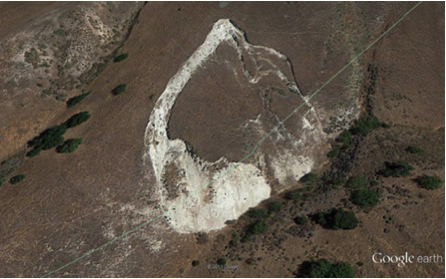Malibu Creek is arguably California’s saltiest coastal creek, and according to one water manager, its unusual saltiness – the salt is not from seawater – is due to leaching of minerals from a vast shale rock layer known as the Monterey Shale Formation in the creek’s northern headwaters in the Simi Foothills.
At the recent Headwaters to Oceans (H2O) conference, Randal Orton, the resource conservation manager at the Las Virgenes Municipal Water District, gave a 15-minute talk on the evidence for this theory and why it makes sense.
I thought it was pretty interesting because I have heard a lot about Malibu Creek’s water quality problems – the septic tanks, the algae and the high bacterial counts, for example – but I had never heard anyone mention the creek’s perpetual brackishness. I had even less of an idea (no clue) on how it might have got this way, which is why I went to his talk, “Why Malibu Creek is so salty: A case study in biogeochemistry.”
The gist of Orton’s theory is that the Monterey Shale Formation is naturally enriched in salts, such as magnesium sulfate (epsom salt), and other compounds that are dissolved out the rock by flowing water.
“Every time it rains it’s like pouring epsom salt into the upper watershed,” Orton told the audience of coastal professionals. Epsom salt is the same stuff you can buy in bags at Rite-Aid as a soak for achy muscles.

The Monterey Shale Formation is exposed at the surface throughout the northern headwaters of Malibu Creek. The white color is largely because of all the salt. Credit: Google earth
The oil industry has known about the Monterey Shale Formation for a long and lucrative time: It’s the source rock for the state’s largest reserve of onshore shale oil. Most of the oil that has been drilled out of the ground in California has come from this formation. (The La Brea Tar Pits in Los Angeles are seepage from the Pico formation, which is part of the larger Monterey formation.)
The point, in terms of water quality, is that the Monterey formation outcrops (comes to the surface) in the northern part of the watershed and has direct contact with water that ultimately feeds into Malibu Creek. As a result, the creek is very salty with sulfate, magnesium, calcium and bicarbonate.
According to the water district, sulfate levels are three times the allowable standard and ten times greater than nearby coastal streams in the Santa Monica Mountains. Some metals that are naturally enriched in the shale have also been found in elevated concentrations in local feeder creeks, their algae and fish, according to the water district.
How salty is the creek? Its electrical conductance (a measure of its total salt content) is between 1,500 and 3,000 micro Siemens per centimeter (µS/cm) in the main stem and 3,000 to 6,000 µS/cm in the headwaters within the Monterey formation; typical coastal creeks in California (and Los Angeles tap water) range from about 500 to 1,000 µS/cm; seawater is about 54,000 µS/cm.
I thought it was cool to learn about the local geology and its ability to affect water quality. It should be noted, though, that Malibu Creek’s water quality issues are a subject of ongoing regulatory debate, and that the Virgenes Municipal Water District is a stakeholder in this process. I have tried to stick to the science and avoid the political alligators.
The Malibu Creek Watershed is one of the last spots in the greater Los Angeles area that has not been built up. It’s in a comparatively natural state, with about 75 percent of the watershed still undeveloped.
Written by Christina Johnson
About California Sea Grant
NOAA’s California Sea Grant College Program funds marine research, education and outreach throughout California. Headquartered at Scripps Institution of Oceanography at the University of California San Diego, California Sea Grant is one of 34 Sea Grant programs in the National Oceanic and Atmospheric Administration (NOAA), U.S. Department of Commerce.